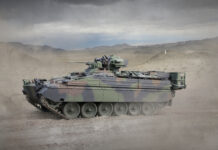On the challenge of mission grade communications at the tactical edge, Macy Summers, President and CEO of Blu Wireless Inc., explains how IEEE mmWave 5G technology gives the front line a ‘ direct connect’ advantage.

5G is being pitched as the way forward for defence communications and 3GPP (the primary global development association for 5G) is working with organisations such as the U.S. Department of Defense (DoD) to further its advancement. While using 3GPP 5G commercial networks, with appropriate security enhancements, may well be applicable to rear echelon and large military base scenarios, it is less suited to tactical and mission grade scenarios.
In this article we’ll explore the evolution of tactical communications, typical use cases of 3GPP 5G in defence as well as its limitations.
A Solution Without a Problem?
When it comes to 3GPP 5G for defence, one might get an impression of ‘a solution looking for a problem’. This is because 3GPP 5G is inherently centralised and has a significant overhead of functions and features not applicable to private (military) networks. It also doesn’t readily conform with pass-through government IT cyber security policies.
That said, where you have a rear echelon or large base, it makes sense to utilise 5G commercial network technology and the features offered by its complex digital infrastructure and, indeed, this is how the industry is pitching it.
At a recent Armed Forces Communications & Electronics Association (AFCEA) event, several leading 3GPP equipment vendors gave presentations on 5G in defence scenarios. However, every example given, bar one, was ‘in-garrison’ rather than in a tactical or battlefield context.
The challenge with traditional carrier-based 3GPP 5G mobile networks is that they require a centralised core network that communications and service features must loop through – and this is usually housed in a rack-mounted computer system. As it isn’t typical to put a core network in everyone’s backpack, centralised 3GPP 5G is unlikely to cut it on the battlefield or in other tactical scenarios. Law enforcement is living this challenge in the USA with FirstNet. The lack of safety-of-life connectivity, in this nationwide example, leaves 3GPP LTE and 5G private networking as a supporting network, not the primary tactical one.
5G Comes in Different Shapes and Forms
IEEE 5G mmWave-based systems use peer-to-peer networking rather than a centralised core (used in ‘mainstream’ 3GPP 5G). 5G mmWave networks are made up of multiple wireless radio nodes that communicate with each other in an overlapping mesh. Self-sufficient and self-managed, they find the fastest, most reliable direct connect paths using line-of-sight wireless communications to transfer data at the fastest rates. They allow for non-line-of-sight connections through ‘daisy chain’ communication, where every node can act as a relay point to ‘shadowed’ (out of range or geographically blocked) correspondents.
One might draw a parallel with digital push-to-talk (PTT, TETRA or P25) radios which have been used at the tactical edge and by a number of first response forces (the police, fire brigade) since the mid-1990s. To this day, push-to-talk, direct-connect, radios remain one of the most robust and reliable communications systems in threat environments.
5G mmWave-based systems present a significant step forward in tactical communications. They are very easy to set up (unlike having to configure a core network) and utilise unlicensed spectrum at 57- 71 GHz V-Band, making them very difficult to detect (LPI/LPD).
A trial of 5G mmWave systems saw the technology interfaced with the networking systems of land vehicles. This use case was then tested in a variety of simulated tactical battlefield scenarios and was shown to provide 360° communications coverage via mesh networking to deliver undisrupted gigabit communication links between vehicles at typical manoeuvring distances.
Why mission grade communication requires different 5G technology
When considering the adoption of 5G in defence, it is important to differentiate between strategic and tactical/mission grade communications, with each echelon operating with different types of information and intelligence. Strategic information is what an adversary will spend a great deal of time and money on to intercept and decrypt, in order to work out battle plans and arrayed forces. Tactical information, however, is perishable so decrypted exploitation is less important. Things change quickly at the tactical edge.
So, while your HQ, supply chain, forward base, command post and tactical front all need to be connected, centralised 3GPP 5G networks won’t stand the test of time in the battlefield. It makes good sense to leverage the 3GPP 5G commercial network for rear echelons, supply chain and large bases. However, 5G mmWave technology is superior when it comes to delivering a secure, stealthy and flexible tactical communications solution.
Macy Summers






